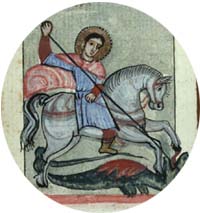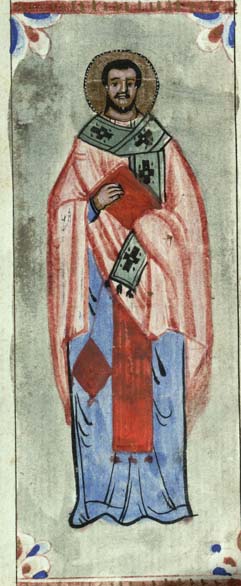| Please note that these pages are from our old (pre-2010) website; the presentation of these pages may now appear outdated and may not always comply with current accessibility guidelines. |
| Please note that these pages are from our old (pre-2010) website; the presentation of these pages may now appear outdated and may not always comply with current accessibility guidelines. |

| There is a brief entry on the last page of the published catalogue of the manuscripts in the library of the Hunterian Museum at Glasgow University, which reads "illustrated Armenian roll." This laconic note, which stands in sharp contrast to the wealth of detail deployed in the description of the 650 other manuscripts in the collection, obscures the fact that this manuscript is not only an item of considerable intrinsic value, but also a particularly well-preserved and finely executed example of its kind. |
|
|
It is in fact an Armenian Prayer Scroll dating from 1661. This pahpanak or hamayil (phylactery) consists of a collection of prayers, biblical texts and magical formulae, and was intended to act as an amulet to protect its owner (who wrote his name on it and carried it on his person) from all ills and dangers. As is the case with most phylacteries, our manuscript is illuminated with portraits of saints and scenes from the life of Christ. The manuscript is in the form of a long (approximately 492 x 8 cm) paper scroll written in one column. Twelve pieces of paper have been glued together to form this scroll. The scroll has been mounted in a wooden box with a glass viewing panel. The scroll begins with an illustration of a vase with flowers, followed by a cross flanked by two peacocks in orange, blue, gold, and grey colours. The first full length portrait in the scroll is of St. Nerses in liturgical vestments, holding the Gospels. This is followed by a prayer of St. Nerses the Gracious for the twenty-four hours of the day. |

St. Nerses |
|
|
The main script is a fine notrgir (i.e. cursive) with rubricated headings and
initials, with some initial lines
written in pale-purple ink. There are
a number of zoomorphic and phyllomorphic initials. The owner, Ant’ani ordi Grigorin, has written his name into the
prayers at several places, thereby effecting the protective properties. His hand
- a fairly casual bolorgir (a larger, more formal script) - stands out clearly from the notrgir of the text;
this indicates that he was not himself the scribe, but had the scroll written
for him. The interpolated name can be seen clearly here, to the right of the
heading in red ink to a prayer for protection against the Evil Eye, evil
tongue, and the preservation of the Servant of God. |
|
|
|
|
|
The third miniature is shown to the left. It is a full length portrait of the Madonna and child in gold, blue and red. It is followed by a supplication to the Mother of God. Six roundels containing portraits and texts are next.
The first roundel is a half-length portrait of Saint Phocas wearing
liturgical vestments, followed by prayers to the saint. The other
illustrated roundel depicts the Archangel Gabriel. The angels Michael,
Baraiel and Saghaniel are also mentioned in the accompanying prayer. |
|
|
|
|
|
There are no other Armenian manuscripts in our Special Collections, but there is at least one other Armenian manuscript in Scotland, held in Edinburgh University Library (New College OR MS 131). It is a catechetical work dealing with the holy rites and doctrines of the Armenian Church, dated 20 January 1149 (= 1 February 1699). We, however, do possess several imprints published at Venice on the island of St. Lazarus by the Mekhitarist (Mxit’ariean) religious community, established there in 1717 by the Armenian Catholic priest Mxit’ar Sebastac’i. A major exhibition Treasures from the Ark: 1700 years of Armenian Christian Art is currently on show at the British Library (until 28 May). |
|
Return to main Special Collections Exhibition Page David Weston April 2001
|